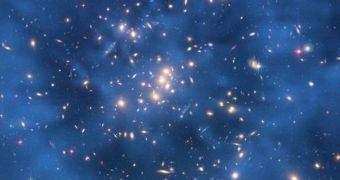The latest evidence in astrophysics appear to confirm the idea that dark matter may exist throughout the Universe in the form of mirror planets, mirror galaxies and mirror stars. The idea is highly-controversial, but the latest studies on the issue tend to tip the scales in its favor.
University of Melbourne physicist Robert Foot says that the results obtained by two of around 30 experiments worldwide searching for dark matter can be explained by a dark matter candidate known to scientists as mirror matter.
The term dark matter is used in astrophysics to refer to the missing mass of the Universe. When astronomers are observing galaxies, they are usually seeing far less matter than they should in order to explain that object's gravitational pull using Albert Einstein's Theory of General Relativity.
As such, experts proposed that the extra mass is accounted for by an unseen quantity, a different type of matter that they called dark matter. For more than three decades, efforts have been underway worldwide to attempt to discover it, but these experiments have largely failed.
What Foot is suggesting is that the DAMA and CoGeNT experiments – both of which are looking for dark matter, and have obtained results that verify each other – discovered signs of mirror matter.
In both cases, the experiments discovered particles that were in a similar mass range. DAMA and COGeNT detected photons that theory states should be produced when dark matter strikes sodium iodide and germanium crystals, respectively.
Theory defines mirror matter as a spatial reflection of ordinary matter, which has an opposite handedness. Baryonic matter particles can be either left- or right-handed, and so mirror matter would have an opposite preferred direction of spin.
Studies have revealed that protons and electrons – among other normal matter particles – tend to prefer left-handedness. What this implies is that the Universe and the laws of nature are not left-right symmetrical (parity-symmetrical).
If mirror matter is made up of particles that have an opposite handedness to their normal matter counterparts, but are otherwise identical in every single way, then the Universe would contain two times more matter than first calculated.
Interestingly, the Cosmos exhibits the other two possible forms of symmetry – rotational and translational. This begs the obvious question of why is the Cosmos not parity-symmetrical as well.
If mirror matter existed, then it would exhibit an opposite preference than normal matter, as in right-handedness. This would basically restore p-symmetry to the entire Cosmos, bringing it into balance again, Daily Galaxy reports.
Foot explains that a process called photon-mirror photon kinetic mixing could explain the interactions between normal and mirror matter, while at the same time providing an elegant explanations for the results obtained by the DAMA and CoGeNT experiments.
One possible way of testing the theory is searching for gravitational microlensing effects, which are produced when the gravitational pull of matter distorts the paths of photons traveling through space.
However, distinguishing instances when microlensing is caused by mirror matter from ones in which the phenomenon is produced by normal matter would be extremely difficult and technically challenging.

 14 DAY TRIAL //
14 DAY TRIAL //